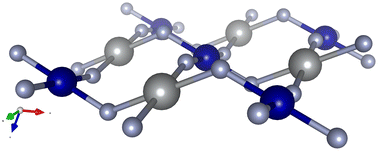Abstract
We present a new compound in the silver–cobalt-fluoride system, featuring paramagnetic silver (d9) and high-spin cobalt (d6), synthesized by solid-state method in an autoclave under F2 overpressure. Based on powder X-ray diffraction, we determined that AgIICoIIIF5 crystallizes in a monoclinic system with space group C2/c. The calculated fundamental band-gap falls in the visible range of the electromagnetic spectrum, and the compound has the character of charge-transfer insulator. AgCoF5 is likely a ferrimagnet with one predominant superexchange magnetic interaction constant between mixed spin cations (Ag–Co) of −62 meV (SCAN result). Magnetometric measurements conducted on a powdered sample allowed the identification of a transition at 128 K, which could indicate magnetic ordering.

- This article is part of the themed collection: Articles behind our 2024 journal covers


 Please wait while we load your content...
Please wait while we load your content...